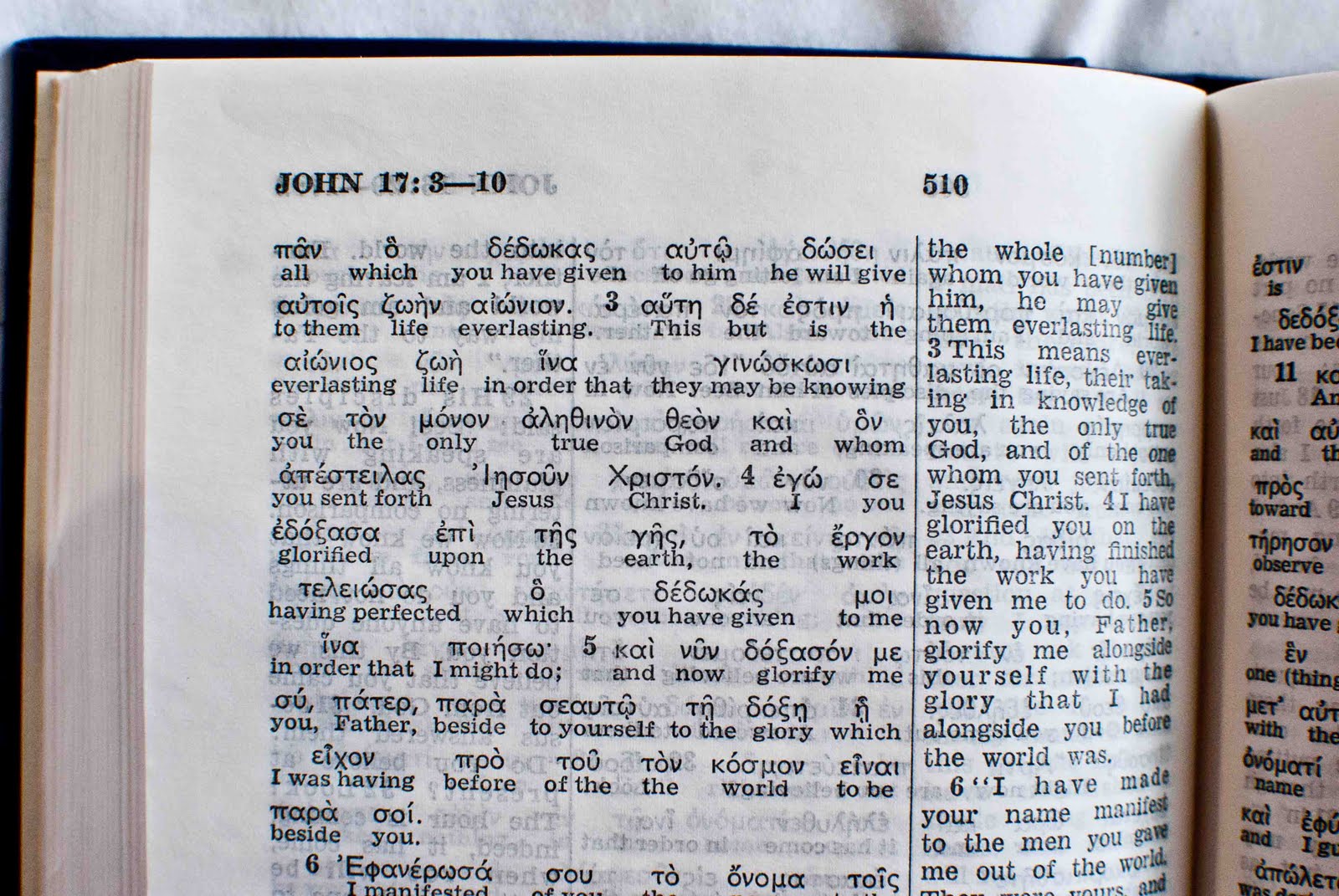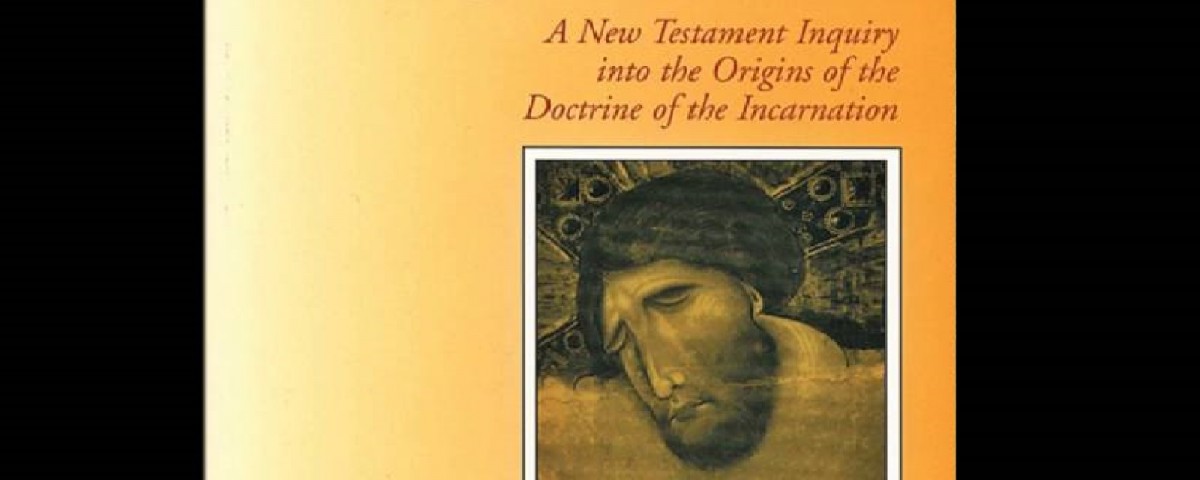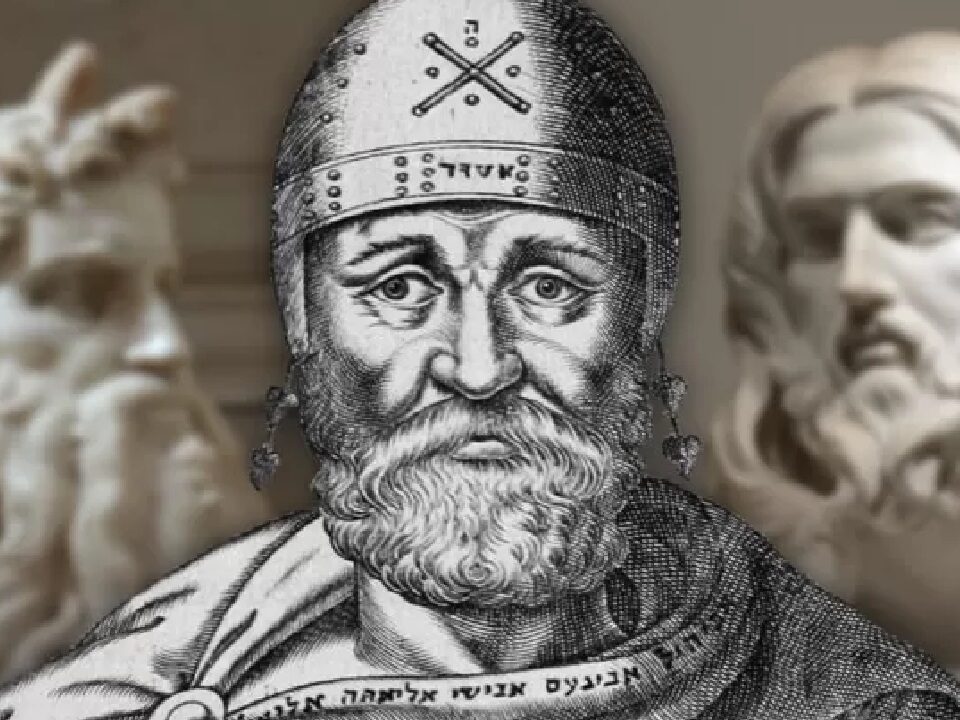
From “Jesus Was Not a Trinitarian” by Anthony Buzzard
October 4, 2016
John 17:5: A Verse to Be Trapped By
November 1, 2016From “Christology in the Making” by James Dunn

“Incarnation, in its full and proper sense, is not something directly presented in scripture. It is a construction built on the variegated evidence to be found there.
Talk of his (Jesus’) pre-existence ought probably in most, perhaps in all, cases to be understood, on the analogy of the pre-existence of the Torah, to indicate the eternal divine purpose being achieved through him, rather than pre-existence of a fully personal kind.” [p. 4]
“The Johannine christology of conscious pre-existent sonship, of self-conscious divinity, belongs most clearly to the developed tradition and not to the original…But if we are to submit our speculations to the text and build our theology only with the bricks provided by careful exegesis we cannot say with any confidence that Jesus knew himself to be…the pre-existent Son of God. [cf. J.A.T. Robinson, ‘The Use of the Fourth Gospel for Christology Today’, CSNT, pp.61-78, who quotes J.A. Baker’s argument that to take the pre-existence motif in John as historical is actually to deny rather than affirm the incarnation: ‘It simply is not possible at once and the same time to share the common lot of humanity, and to be aware of oneself as one who has existed from everlasting with God…You cannot have both the Jesus of John 9:58 as a piece of accurate reporting and the doctrine of the Incarnation’ (The Foolishness of God, Darton, Longman & Todd 1970, p.144; Fount 1975, p.154).” p.32, f.125.
Is then thought of Jesus’ birth as the incarnation of a pre-existent Son of God implied here [in Gal 4.4]? Would Paul’s readers have drawn such an inference? Could Paul have expected his readers to recognize such an implication? …there seems to have been little real precedent for such an idea of incarnation, very little which might have prompted such an inference or invited such an implication.[1]…such language only appears in Christian writings of the second century subsequent to the ideas of virginal conception in Matthew and Luke and the sending of the pre-existent Logos in John and as the harmonization of them (Ignatius, Eph. 7.2; Aristides, Apology 15.1; and especially Justin, Apol. 1.21.1[2]; 32.10-14[3]; 63.15f.[4]; Dial. 45.4[5]; 84.2[6]; 85.2[7]; 127.4[8]). It follows that if Paul intended to imply what we now call the doctrine of incarnation in Gal 4.4 he would have been taking a radically new step, something his readers could hardly have expected to come from a Jew.
[The closest parallels would mislead rather than illuminate Paul’s meaning. In particular, if the language had indeed suggested the idea of a ‘miraculous’ birth, anyone familiar with the Jewish scriptures would presumably have thought of births to women who were barren or past child-bearing age, like Sarah (Gen. 17.15f. – ‘God said to Abraham…“I will give you a son by he’”’) or Rachel (Gen.30.22 – ‘God opened her womb’.]
And if he [Paul] intended to take that step we would have expected his earliest recorded intimation of it to be a much more explicit and careful exposition (cf. the care he takes to expound his understanding of who the seed of Abraham really are – Gal. 3).
Had Paul indeed taught a doctrine of incarnation (the pre-existence of the Son of God, the man Christ Jesus) in his mission it would inevitably have been open to misunderstanding and abuse…so that a greater clarification and fuller exposition of it would almost certainly have appeared elsewhere in his writings. It does not seem a very sound basis for an exegesis of Gal 4.4 to argue both that Paul had already taught an explicit doctrine of incarnation, and also that such a novel teaching caused scarcely a ripple in the often troubled waters of the Pauline mission. In short, it would appear unwise…that Paul’s readers would have at once recognized an allusion to a specific and already well established Christian teaching on Jesus as the incarnate Son of God.
One further and rather surprising consideration seems to emerge from all this. Since what certainly became the Christian idea of incarnation would probably have sounded strange to Paul’s hearers (and to Paul?), perhaps Christian keenness to find an incarnation interpretation here has pushed exegesis in the wrong direction. Perhaps indeed ‘born of woman’…is to be understood as a denial of a simplistic view of Jesus as a divine being come to earth. The one sent as God’s Son was one ‘born of woman’, (simply) a man, not a divine being metamorphosed into or appearing as a human being…perhaps the Christological thrust is simply that ‘God sent forth (directly, not by an angel) his Son (not some heavenly being, but one) born of woman, born under the law…’
It has become steadily clear that Gal 4.4 cannot be taken, as it so often is, as making a straightforward assertion or embodying an obvious presupposition that Jesus was the incarnation of a pre-existent divine being, the Son of God in that sense…In short, we cannot safely conclude from Gal 4.4 that Paul believed in or was already teaching a doctrine of incarnation. [pp. 42-44]
- 6. Jesus’ Divine Sonship in the Post-Pauline Writings of the New Testament
- 6.2 Matthew…Son of God is the most important Christological affirmation for Matthew [14.33; 16.16]…confirmed by the considerable expansion of talk of God as Father in the sayings of Jesus…
At two points Matthew perhaps comes closer to attributing pre-existence to Jesus as Son of God than any Christian writer before him…by appending 11.28-30 to the Q passage (11.25-7/Luke 10.21f.), he identifies Jesus as Wisdom, and though thought of pre-existence is not present in this context it is but a step away, since Wisdom was already familiarly thought of as pre-existent…though here too it should be noted that [in Mat 28.19] the idea of pre-existence is absent…
One of the oddest features [in the account of the virgin birth] is the absence of Son of God terminology; in the birth narratives Jesus is called ‘son (of God)’ by implication only at 2.15, where the flight to Egypt is taken as a step towards his fulfillment of Hos. 11.1…But closer analysis of Mat 1-2 makes it quite clear, as R. E. Brown’s masterly study shows, that Matthew’s intention in chapter 1 is to give an account of the divine origin of Jesus—not mere Son of David, but also Son of God; descended from David sure enough (1.1-17), but more important, conceived by the power of the Holy Spirit (1.18-20)[9]…this was an unheard of step to take, for, as Justin Martyr rightly insisted long ago (Apol. 1.33), it claimed for Jesus a unique conception—the offspring of a human mother, but through an act of God’s creative power, not through sexual intercourse with a divine being. The point which bears upon our study is that Matthew presumably understands this as Jesus’ origin, as the begetting (= becoming) of Jesus to be God’s Son (1.16, 20). As Brown notes, there is in Matthew ‘no suggestion of an incarnation whereby a figure who was previously with God takes on flesh’[10].
In short…Matthew has extended the understanding of Jesus’ divine sonship by dating it from his conception and attributing that to the (creative) power of the Spirit… [pp. 48-50]
The desire to find and maintain a single Christian orthodoxy always tempts the Christian to harmonize and synthesize where possible…That might be argued…on the ground of some dogmatic premise, but not into terms of exegesis. [‘Son of God’, pgs. 61-62]
…one can hardly argue from the usage of the Similitudes itself that the Son of Man was an already well-known figure, or that the author was equating two established and hitherto distinct heavenly beings – the Chosen One (the Messiah) and the Son of Man…
It is certainly not beyond question whether the language was intended as a way of expressing the divine purpose ‘before the world was created’ for the Son of Man, rather than the Son of Man’s personal pre-existence, since the Son of Man is finally identified as Enoch himself (71.14). It is unlikely that Enoch was thought to have pre-existed or to be the incarnation of the Son of Man since the Enoch speculation begins from the account of his translation (Gen 5.24)…Dan 7.13f. would have been likely to suggest something more like apotheosis or exaltation rather than pre-existence.
…in our sources we have nothing to show that Jesus was ever identified with Enoch. [The most obvious parallel was in Jesus’ resurrection/ascension (understood as a translation to heaven like those of Enoch and Elijah) with his parousia (not his earlier life) seen as the return to earth of the one thus exalted – particularly Acts 1.9-11 (cf. 2K 2.9-12); 3.19-21…]
All this makes it very doubtful whether Jewish speculation regarding Enoch and Elijah in heaven ever influenced earliest christology or provided a stimulus towards an assessment of Jesus as one who had been reserved (or hidden) in heaven prior to his mission on or coming to earth – very doubtful too whether Jewish speculation regarding Enoch and Elijah had developed sufficiently prior to AD 70 to be able to provide such a stimulus or to explain the Johannine presentation of Jesus as the Son of Man who had ascended whence he first descended. Such indications as there are point more to the decades following AD 70 as the period when such Jewish (and Jewish-Christian) speculation regarding Elijah and Enoch (and others) began to blossom. [pp 75-95]
Now Adam was certainly not thought of as pre-existent though perhaps strictly speaking as pre-historical, or, being the first man on the earth, as transhistorical/typical….If Christ walks in Adam’s footsteps then Christ need be no more pre-existent than Adam…Nor indeed is there any implication that Christ was contemporaneous with Adam, acting in a similarly transhistorical situation…Christ always presupposes Adam, Christ’s odyssey presupposes the plight of Adam, of Adam’s offspring. As 1 Cor 15:45ff insists, the temporal order is clear: Adam first, Christ second – Christ is last Adam, Adam precedes Christ. Adam was not a copy of a pre-existent Christ, but a “type of him who was to come” [Rom. 5:14]…The Philippian hymn does not intend to affirm that Jesus was as historical or as pre-historical as Adam, but that the choice confronting Christ was as archetypal and determinative for mankind as was Adam’s; weather the choice was made by the pre-existent Christ or the historical Jesus is immaterial to the Philippian hymn.” [‘The Last Adam’, pgs. 119-120]
[1] Cf. G. Dalman, The Words of Jesus, ET 1902: ‘The statements as to preexistence in the Similitudes of Enoch, of 2 Esdras, and in Pesikta Rabbati, do not presuppose any human birth of Messiah. He is to make his appearance upon earth as a fully developed personality. And this is quite distinct from the later Jewish doctrine of the pre-existence of the souls of all men. Judaism has never known anything of a pre-existence peculiar to the Messiah antecedent to his birth as a human being. Baldensperger, [Das Selbstbewusstein Jesu im Lichte der messianischen Hoffnungen seiner Zeit2 (1892), 85. In other points, too, the statements of this book on Jewish matters require careful revision.] nevertheless, holds that from the date of the Similitudes of Enoch, “the heavenly pre-existence of the Messiah” attained the position of a “dogma in apocalyptic circles.” But we have seen that after the Similitudes of Enoch the only representatives of the idea independent of Enoch are 2 Esdras in the first Christian century, and the Appendix to Pesikta Rabbati, independently of both these sources, in the seventh or eighth century. The dominance of the idea in any Jewish circle whatever cannot seriously be upheld.’ (p. 131-32)
[2] “…we say also that the Word, who is the first-birth [first born] of God, was produced without sexual union…”
[3] “…those men who believe in Him [Jesus] in whom [abides] the seed of God, the Word…He who should appear would have blood, though not of the seed of man, but of the power of God. And the first power after God the Father and Lord of all is the Word, who is also the Son…He took flesh and became man…the blood should not be of human seed, but of divine power…And Isaiah, another prophet, foretelling the same things in other words, spoke thus: ‘A star shall rise out of Jacob, and a flower shall spring from the root of Jesse; and His arm shall the nations trust.’ And a star of light has arisen, and a flower has sprung from the root of Jesse—this Christ. For by the power of God He was conceived by a virgin of the seed of Jacob…”
[4] “Now the Word of God is His Son, as we have before said. And He is called Angel and Apostle… so much is written for the sake of proving that Jesus the Christ is the Son of God and His Apostle, being of old the Word, and appearing sometimes in the form of fire, and sometimes in the likeness of angels; but now, by the will of God, having become man for the human race…The Jews, accordingly, being throughout of opinion that it was the Father of the universe who [spoke] to Moses, though He who [spoke] to him was indeed the Son of God, who is called both Angel and Apostle…the Father of the universe has a Son; who also, being the first-begotten Word of God, is even God. And of old He appeared in the shape of fire and in the likeness of an angel to Moses and to the other prophets; but now in the times of your reign, having, as we before said, become Man by a virgin, according to the counsel of the Father…”
[5] “…Christ, Son of God, who was before the morning star and the moon, and submitted to become incarnate, and be born of this virgin of the family of David…”
[6] “…the prophecy, ‘Behold, the virgin shall conceive, and bear a son,’ was uttered respecting Him. For if He to whom Isaiah referred was not to be begotten of a virgin, of whom did the Holy Spirit declare, ‘Behold, the Lord Himself shall give us a sign: behold, the virgin shall conceive, and bear a son?’ For if He also were to be begotten of sexual intercourse, like all other first-born sons, why did God say that He would give a sign which is not common to all the first-born sons? But that which is truly a sign, and which was to be made trustworthy to mankind,—namely, that the first-begotten of all creation should become incarnate by the Virgin’s womb, and be a child…as if great events were to be inferred if a woman should beget from sexual intercourse: which indeed all young women, with the exception of the barren, do; but even these, God, if He wills, is able to cause [to bear]. For Samuel’s mother, who was barren, brought forth by l the will of God; and so also the wife of the holy patriarch Abraham [Sarah]; and Elisabeth, who bore John the Baptist, and [others]. So that you must not suppose that it is impossible for God to do anything He wills. And especially when it was predicted that this would take place, do not venture to pervert or misinterpret the prophecies, since you will injure yourselves alone, and will not harm God.”
[7] “For every demon, when exorcised in the name of this very Son of God—who is the First-born of every creature, who became man by the Virgin…”
[8] “Therefore neither Abraham, nor Isaac, nor Jacob, nor any other man, saw the Father and ineffable Lord of all, and also of Christ, but [saw] Him who was according to His will His Son, being God, and the Angel…whom also it pleased Him to be born man by the Virgin; who also was fire when He conversed with Moses from the bush.”
[9] Brown, Birth, §5; see also, K. Stendahl, ‘Quist et Unde? An Analysis of Matt. 1-2’, Judentum, Urchristentum, Kirche, 1964, pp. 94-105; R. Pesch, ‘Der Gottessohn im mattaischen Evangelienprolog (Matt. 1-2)’, Biblica 48, 1967, pp. 395-420 (particularly pp. 408-19); Kingsbury, Matthew, pp. 42-53.
[10] Brown, Birth, p. 141; Fuller, ‘Christological Moment’, p. 39. Matt. 1.23, ‘”His name shall be called Emmanuel” (which means, ‘God with us’), does not affect this conclusion, since the child of whom Isaiah speaks would have been understood to be simply a symbol of God’s purpose for Judah. Matthew would see it fulfilled in complete measure by Jesus, but not in a literal sense as though he were identifying Jesus with God, only in the sense that Jesus is the full (fulfilled) expression of God’s presence [purpose] with His people (Brown, Birth, p. 150 n. 52).

